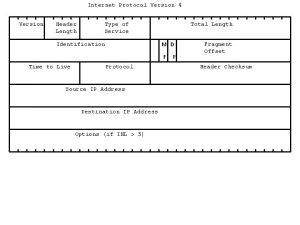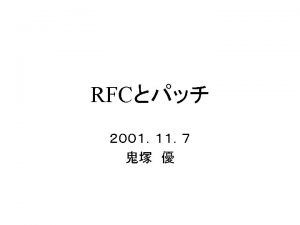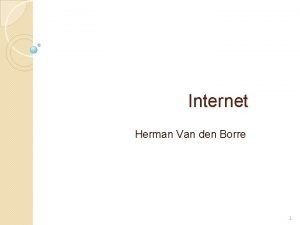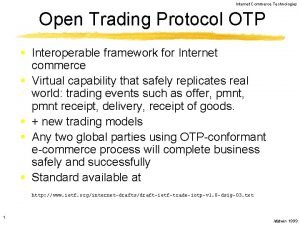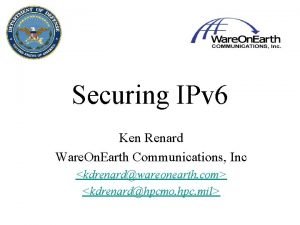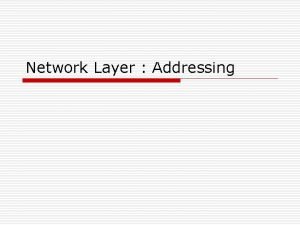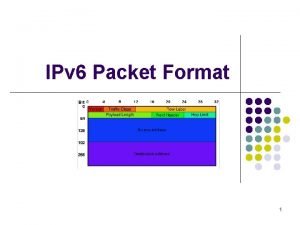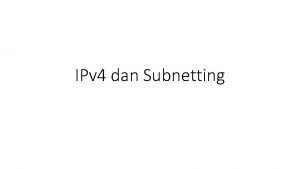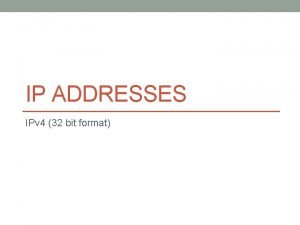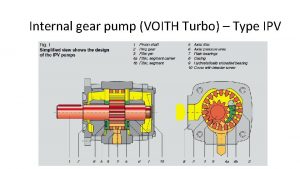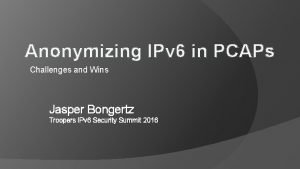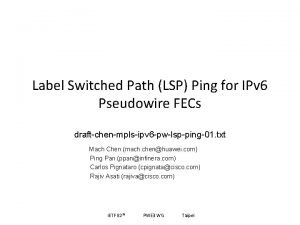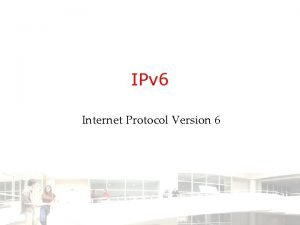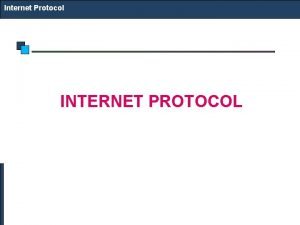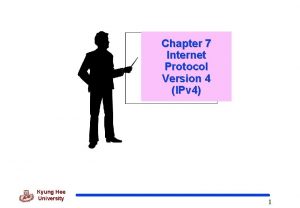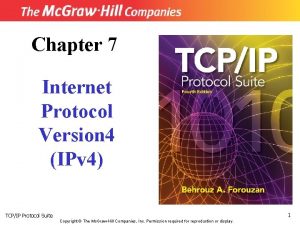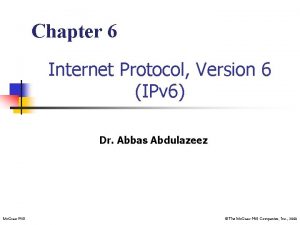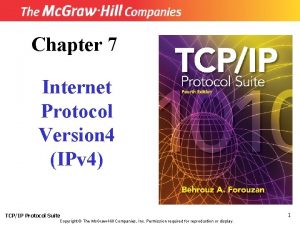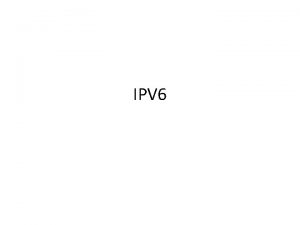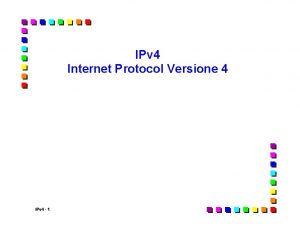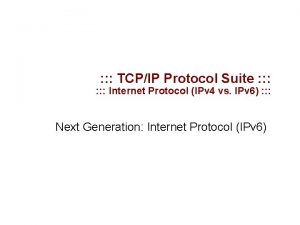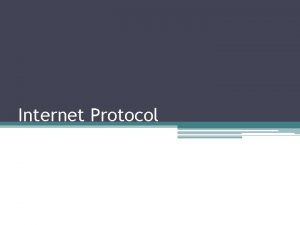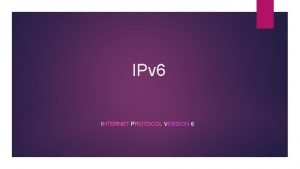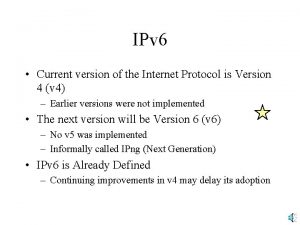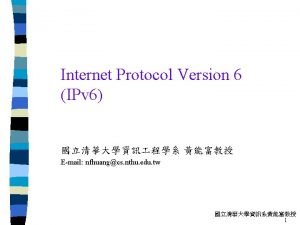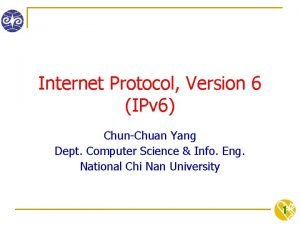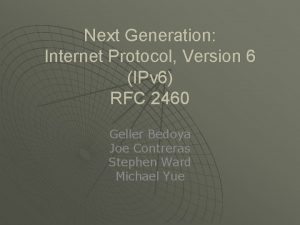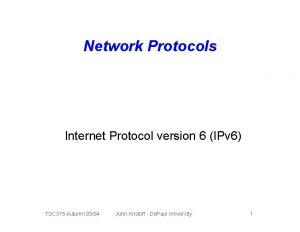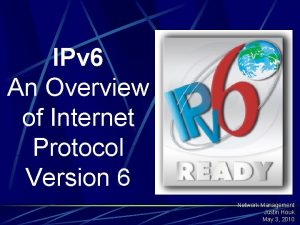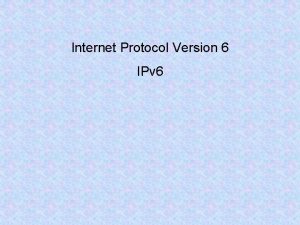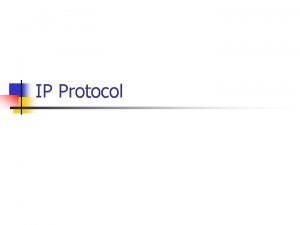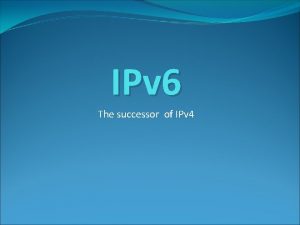Chapter 6 Internet Protocol Version IPv 6 Instructor























- Slides: 23

Chapter 6: Internet Protocol Version (IPv 6) Instructor: Mr. Malik Zaib

Chapter 6 Objectives �The CCENT Topics Covered in this chapter include: � IP addressing (IPv 4 / IPv 6) � Identify the appropriate IPv 6 addressing scheme to satisfy addressing requirements in a LAN/WAN environment � Describe the technological requirements for running IPv 6 in conjunction with IPv 4 such as dual stack � Describe IPv 6 addresses � � � Global unicast Multicast Link local Unique local eui 64 autoconfiguration � IP Routing Technologies � Configure and verify OSPF (single area) � Configure OSPF v 3 2

Why Do We Need IPv 6? Well, the short answer is because we need to communicate and our current system isn’t really cutting it anymore. It’s kind of like the Pony Express trying to compete with airmail! Consider how much time and effort we’ve been investing for years while we scratch our heads to resourcefully come up with slick new ways to conserve bandwidth and IP addresses. Sure, variable length subnet masks (VLSMs) are wonderful and cool, but they’re really just another invention to help us cope while we desperately struggle to overcome the worsening address drought. IPv 4 has only about 4. 3 billion addresses available—in theory—and we know that we don’t even get to use most of those! Sure, the use of Classless Inter-Domain Routing (CIDR) and Network Address Translation (NAT) has helped to extend the inevitable dearth of addresses, but we will still run out of them, and it’s going to happen within a few years. China is barely online, and we know there’s a huge population of people and corporations there that surely want to be.

IPv 6 address example As you can clearly see, the address is definitely much larger. But what else is different? Well, first, notice that it has eight groups of numbers instead of four and also that those groups are separated by colons instead of periods. And hey, wait a second… there are letters in that address! Yep, the address is expressed in hexadecimal just like a MAC address is, so you could say this address has eight 16 bit hexadecimal colon-delimited blocks.

Address Types Unicast Packets addressed to a unicast address are delivered to a single interface. For load balancing, multiple interfaces across several devices can use the same address, but we’ll call that an anycast address. Global unicast addresses (2000: : /3) These are your typical publicly routable addresses and they’re the same as in IPv 4. Global addresses start at 2000: : /3. Figure 6. 2 shows a how a unicast address breaks down. The ISP can provide you with a minimum /48 network ID, which in turn provides you 16 -bits to create a unique 64 -bit router interface address. The last 64 -bits are the unique host ID. Link-local addresses (FE 80: : /10) These are like the Automatic Private IP Address (APIPA) addresses that Microsoft uses to automatically provided addresses in IPv 4 in that they’re not meant to be routed. In IPv 6 they start with FE 80: : /10.

Address Types Continuous…. Unique local addresses (FC 00: : /7) Unique local addresses were designed to replace site-local addresses, so they basically do almost exactly what IPv 4 private addresses do: allow communication throughout a site while being routable to multiple local networks. Multicast (FF 00: : /8) Again, same as in IPv 4, packets addressed to a multicast address are delivered to all interfaces tuned into the multicast address. Sometimes people call them “one-to-many” addresses. It’s really easy to spot a multicast address in IPv 6 because they always start with FF. Anycast These are referred to as one-to-nearest addresses.

Special IPv 6 addresses

IPv 6 global unicast addresses

Manual Address Assignment In order to enable IPv 6 on a router, you have to use the ipv 6 unicast-routing global configuration command: Corp(config)#ipv 6 unicast-routing By default, IPv 6 traffic forwarding is disabled, so using this command enables it. You can now use the interface configuration command ipv 6 address <ipv 6 prefix>/<prefix-length> [eui-64] Here’s an example: Corp(config-if)#ipv 6 address 2001: db 8: 3 c 4 d: 1: 0260: d 6 FF. FE 73: 1987/64 or you can use the eui-64 option. Remember, the EUI-64 (extended unique identifier) format allows the device to use its MAC address and pad it to make the interface ID. Check it out: Corp(config-if)#ipv 6 address 2001: db 8: 3 c 4 d: 1: : /64 eui-64

Stateless Autconfiguration EUI-64 interface IDassignment Autoconfiguration is an especially useful solution because it allows devices on a network to address themselves with a link-local unicast address as well as with a global unicast address. Let’s say I have a device with a MAC address that looks like this: 0060: d 673: 1987. After it’s been padded, it would look like this: 0260: d 6 FF: FE 73: 1987. So where did that 2 in the beginning of the address come from?

Two Steps to IPv 6 autoconfiguration

IPv 6 autoconfiguration example In this figure, the Branch router needs to be configured, but I just don’t feel like typing in an IPv 6 address on the interface connecting to the Corp router. I also don’t feel like typing in any routing commands, but I need more than a link-local address on that interface. So basically, I want to have the Branch router work with IPv 6 on the internetwork with the least amount of effort. Using the command ipv 6 address autoconfig, the interface will listen for RAs and then, via the EUI-64 format, it will assign itself a global address

DHCPv 6 (Stateful) In IPv 6, the RS and RA process happens first, so if there’s a DHCPv 6 server on the network, the RA that comes back to the client will tell it if DHCP is available for use. If a router isn’t found, the client will respond by sending out a DHCP solicit message, which is actually a multicast message addressed with a destination of ff 02: : 1: 2 that calls out, “All DHCP agents, both servers and relays. ”

IPv 6 header When IPv 6 designers devised the header, they created fewer, streamlined fields that would also result in a faster routed protocol at the same time.

IPv 6 header �Version This 4 -bit field contains the number 6, instead of the number 4 as in IPv 4. �Traffic Class This 8 -bit field is like the Type of Service (To. S) field in IPv 4. �Flow Label This new field, which is 24 bits long, is used to mark packets and traffic flows. A flow is a sequence of packets from a single source to a single destination host, an anycast or multicast address. The field enables efficient IPv 6 flow classification.

IPv 6 header �Payload Length IPv 4 had a total length field delimiting the length of the packet. IPv 6’s payload length describes the length of the payload only. �Next Header Since there are optional extension headers with IPv 6, this field defines the next header to be read. This is in contrast to IPv 4, which demands static headers with each packet. �Hop Limit This field specifies the maximum number of hops that an IPv 6 packet can traverse. �Source Address This field of 16 bytes or 128 bits identifies the source of the packet. �Destination Address This field of 16 bytes or 128 bits identifies the destination of the packet.

ICMPv 6 Figure shows how ICMPv 6 has evolved to become part of the IPv 6 packet itself.

ICMPv 6 The ICMPv 6 packet is identified by the value 58 in the Next Header field, located inside the ICMPv 6 packet. The Type field identifies the particular kind of ICMP message that’s being carried, and the Code field further details the specifics of the message. The Data field contains the ICMPv 6 payload.

ICMPv 6 is carried after the basic IPv 6 header as an extension. ICMPv 6 packet is identified by the value 58 in the next header field, shows its type. ICPMv 6 is used for router/neighbor Solicitation and advertisement. Neighbor Discovery(NDP): ARP is renamed as NDP in ICMPv 6 used for finding the address of other devices on the local link. Neigbor Discover Functions: � Determining the MAC address of neighbors � Router solicitation (RS) FF 02: : 2 � Router advertisements (RA) FF 02: : 1 � Neighbor solicitation (NS) � Neighbor advertisement (NA) � Duplicate address detection (DAD)

Router solicitation (RS) and router advertisement (RA) IPv 6 hosts send a router solicitation (RS) onto their data link asking for all routers to respond, and they use the multicast address FF 02: : 2 to achieve this. Routers on the same link respond with a unicast to the requesting host, or with a router advertisement (RA) using FF 02: : 1.

IPv 6 static and default routing First, I created a static route on the Corp router to the remote network 2001: 1234: 4321: 1: : /64 using the next hop address. I could’ve just as easily used the Corp router’s exit interface. Next, I just set up a default route for the Branch router with : : /0 and the Branch exit interface of Gi 0/0

OSPFv 3 � It is a link state routing protocol that divides an entire internetwork or AS into areas, creating a hierarchy. � In OSPF version 2, the router ID (RID) is determined by either the highest IP addresses assigned to the router or one you manually assigned. In version 3, you assign the RID and area ID, which are both still 32 -bit values. � Adjacencies and next-hop attributes now use link-local addresses. OSPFv 3 still uses multicast traffic to send its updates and acknowledgments, with the addresses FF 02: : 5 for OSPF routers and FF 02: : 6 for OSPF-designated routers as replacements for OSPV 2 224. 0. 0. 5/6 addresses. To enable IPv 6 routing, use command: Corp(config)#ipv 6 unicast-routing OSPF Commands, � Router 1(config)#ipv 6 router osfp 10 � Router 1(config-rtr)#router-id 1. 1 � Router 1(config-if)#ipv 6 ospf 10 area 0

Written Labs and Review Questions �Read through the Exam Essentials section together in class �Open your books and go through all the written labs and the review questions. �Review the answers in class. 23
 Ipv protocol
Ipv protocol Internet header length
Internet header length Security architecture for the internet protocol
Security architecture for the internet protocol Internet transport protocol in computer networks
Internet transport protocol in computer networks Protocol
Protocol Internet official protocol standards
Internet official protocol standards Internet protocol cursus
Internet protocol cursus Iotp
Iotp Voice over internet protocol
Voice over internet protocol Iptv internet protocol television
Iptv internet protocol television Adaptive internet protocol
Adaptive internet protocol Internet or internet
Internet or internet Ipv meaning
Ipv meaning Ipv 4 terdiri dari... *
Ipv 4 terdiri dari... * Ipv format
Ipv format Ipv 4 terdiri dari...
Ipv 4 terdiri dari... Ipv format
Ipv format Voith насос voith ipva, ipvap
Voith насос voith ipva, ipvap ۰میکنی
۰میکنی Ipv meaning
Ipv meaning Ipv foo
Ipv foo Modelo de ipv en cuba
Modelo de ipv en cuba Ping ipv
Ping ipv Kuiz ujian buaya
Kuiz ujian buaya

